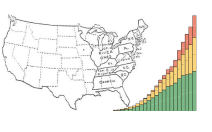The first systematic attempt to define the urban population of the United States occurred after the 1870 census when the urban population was defined generally as the population in places (generally, incorporated cities and towns) of 8,000 or more population. The urban threshold was dropped to 4,000 for the 1880 census, and to 2,500 for the 1910 census. The remainder of the population was classified as rural. For a comprehensive description, see Leon E. Truesdell (1949), “The Development of the Urban-Rural Classification in the United States: 1874 to 1949,” U. S. Bureau of the Census, Current Population Reports, Series P-23, No. 1. During the 1930s, the Census Bureau developed an historical series on the population of all urban places (2,500 or more population) since 1790. This work underlies the tables on the urban population by size of place since 1790 that first appeared in 1940 census reports and that have been updated in each subsequent census. A major change in the definition of urban occurred in the 1950 census with the introduction of urbanized areas, defined generally as cities of 50,000 or more population and their surrounding densely settled urban fringe, whether or not in incorporated places. In addition, unincorporated places of 2,500 or more population outside of urbanized areas were also defined as urban, starting in 1950. In the 2000 census, urban clusters were introduced, which represented an extension of the urbanized area concept down to densely settled areas with 2,500 up to 50,000 population.
The farm population (population living on farms) was first defined in the 1920 census; however, estimates of the farm population were developed back to 1880, as shown in Leon E. Truesdell (1960), “Farm Population: 1880 to 1950,” U.S. Bureau of the Census, Technical Paper No. 3. Formal criteria for defining a farm were introduced in the 1950 and 1960 censuses. In 2000, an occupied housing unit was defined as a farm residence if it was on a property of at least one acre with at least $1,000 of agricultural products sold in 1999, and persons living on the farm property in multiunit buildings or in group quarters (e.g., dormitories) were not included in the farm population. Starting with 2010, data on the farm population are no longer available from the decennial census because of the elimination of the long-form questionnaire. Data on the farm population are not available from the American Community Survey (ACS). See About the Chartbook, Addition of Data for 2010.
For information on the many changes over time in the definition of urban, urbanized areas, and the farm population, see Data Sources.
Figures
2-1. Population by Urban-Rural and Farm Residence for the United States: 1790 to 2010
2-4. Percent Urban in the Population by Size of Place for the United States: 1790 to 2010
2-8. Ten Largest Cities in the United States: 1790 to 2010
